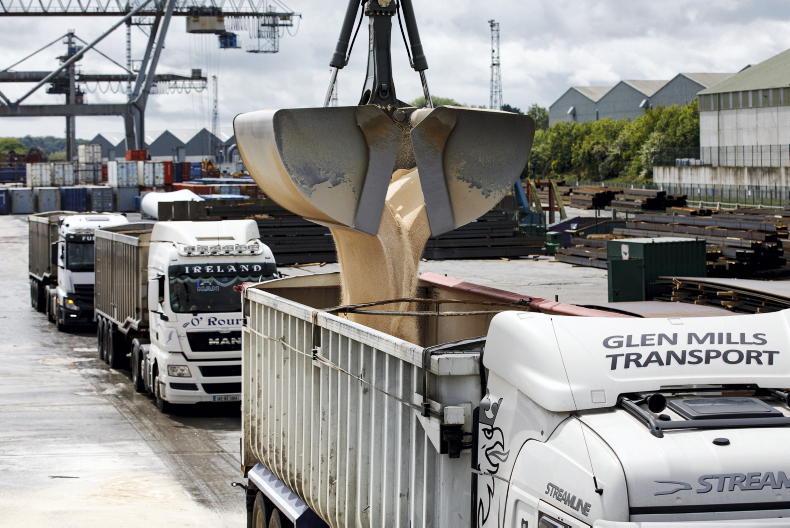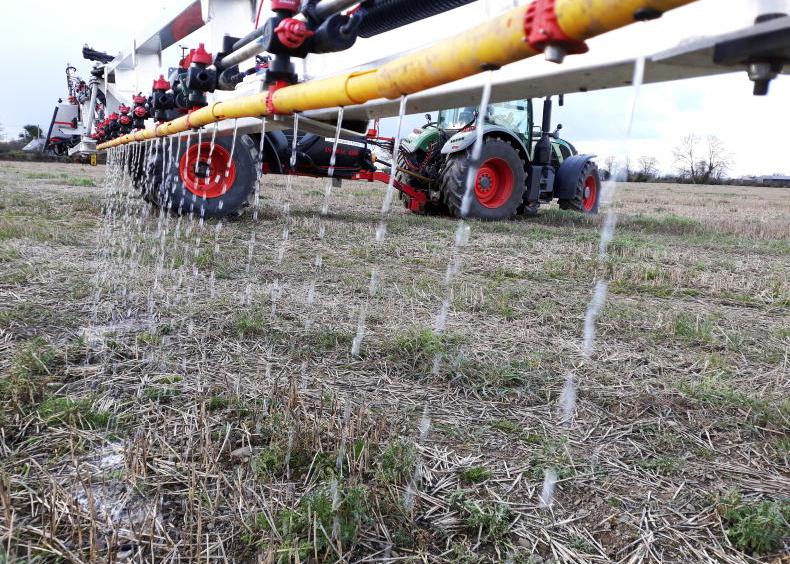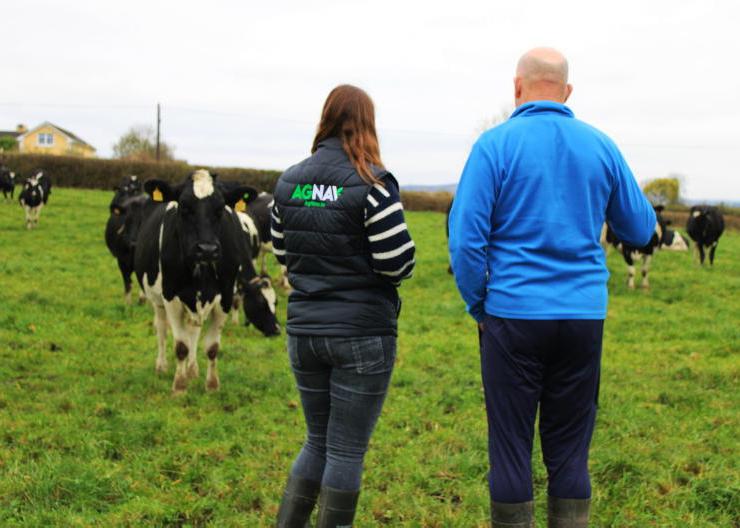Agricultural emissions could decrease by up to 20% by 2030, if most of the measures in the Climate Action Plan 2023, AgClimatise and the Teagasc marginal abatement cost curve (MACC) are implemented, the Environmental Protection Agency (EPA) has said.
However, this means the sector is projected to miss its sectoral emissions ceiling in 2030 by 5%, the EPA said in its greenhouse gas (GHG) emissions projections report for 2022 to 2040.
“Total emissions from the agriculture sector are projected to decrease by between 4% and 20% over the period 2021 to 2030.
"Savings are projected from a variety of measures, including switching to different fertilisers, limits on nitrogen fertiliser usage and bovine feed additives.
“The higher-ambition scenario assumes that most of the measures outlined in Climate Action Plan 2023, AgClimatise and Teagasc (MACC) are in place,” it stated.
Data projections
In 2021, the sector contributed 38% of Ireland’s total emissions. By 2030, the sector is projected to account for 43% of Ireland’s total emissions.
The data underpinning the agriculture projections is based on an updated analysis undertaken by Teagasc of the projected animal populations, crop areas and fertiliser use.
The EPA has projected a fall in emissions in two scenarios for 2030 - one scenario could see emissions fall by 4% and another scenario could see emissions fall by up to 20%.
4% reduction scenario
Emissions will fall by 4% over the period 2021-2030 from 23.6 to 22.8 million tonnes of CO2 equivalent (MT CO2 eq) under the ‘with existing measures’ scenario.
This scenario is a projection of future emissions based on the measures currently implemented and actions which are committed to by Government.
These measures must have been in place by the end of 2021. Examples include nitrates action programme actions, such as low emission slurry spreading (LESS) on all derogation farms.

“Current evidence shows that the use of LESS has penetrated to non-derogation farms. Therefore, the target of 90% of slurries spread by LESS by 2027 as per AgClimatise is applied,” the EPA said.
Other examples include a rise in lime applications to 2m tonnes per annum by 2030 and the use of protected urea remaining at current levels.
20% reduction scenario
Emissions are projected to decrease to 19MT CO2 eq over the period 2021-2030 under the ‘with additional measures’ scenario.
This scenario assumes all of the existing measures plus the measures outlined in Climate Action Plan 2023, the Teagasc MACC, AgClimatise and Teagasc ammonia MACC.
These measures include:
Reduction in crude protein in pig diets.Use of slurry amendments for cattle and pigs.All slurry stores (cattle and pig) to be covered by 2027.Drying of poultry manure.Use of LESS techniques for pig slurry.Replacing 65% of CAN and compound fertiliser products with protected urea by 2030.Target fertiliser sales at 350,000t of nitrogen (N) by 2025 and 325,000t N by 2030.Methane reduction measures: slurry additives to reduce methane emissions, reduced slaughter age for cattle, reduced age to first calving, feed additives (cattle), dairy economic breeding index (EBI) optimisation.Land use
Emissions from the land use, land use change and forestry (LULUCF) sector are projected to increase over the period 2021 to 2030.
This is as a result of the current forestry crop reaching harvesting age and it changes from a carbon sink to a carbon source.
“Planned policies and measures for the sector, such as increased afforestation, water table management on agricultural organic soils and peatland rehabilitation, are projected to reduce the extent of the emissions increase,” the EPA said.
Overall, the EPA has said that Ireland will fall short of its 51% cut in GHG emissions by 2030 and instead is projected to achieve a reduction of 29%.
Almost all sectors of the economy are on a trajectory to exceed their national sectoral emissions ceilings for 2025 and 2030, including agriculture, electricity and transport and the first two carbon budgets (2021-2030) will not be met, and “by a significant margin”.

The EPA said reaching the 2030 target requires implementing policies that “deliver emissions reductions across all sectors in the short term”.
“Ireland needs to fully implement the actions in the Climate Action Plan 2023 that have been defined; firm up the actions that currently don’t have associated policies and measures, such as diversification in agriculture; and identify and implement further policies and measures,” it said.
Agricultural emissions could decrease by up to 20% by 2030, if most of the measures in the Climate Action Plan 2023, AgClimatise and the Teagasc marginal abatement cost curve (MACC) are implemented, the Environmental Protection Agency (EPA) has said.
However, this means the sector is projected to miss its sectoral emissions ceiling in 2030 by 5%, the EPA said in its greenhouse gas (GHG) emissions projections report for 2022 to 2040.
“Total emissions from the agriculture sector are projected to decrease by between 4% and 20% over the period 2021 to 2030.
"Savings are projected from a variety of measures, including switching to different fertilisers, limits on nitrogen fertiliser usage and bovine feed additives.
“The higher-ambition scenario assumes that most of the measures outlined in Climate Action Plan 2023, AgClimatise and Teagasc (MACC) are in place,” it stated.
Data projections
In 2021, the sector contributed 38% of Ireland’s total emissions. By 2030, the sector is projected to account for 43% of Ireland’s total emissions.
The data underpinning the agriculture projections is based on an updated analysis undertaken by Teagasc of the projected animal populations, crop areas and fertiliser use.
The EPA has projected a fall in emissions in two scenarios for 2030 - one scenario could see emissions fall by 4% and another scenario could see emissions fall by up to 20%.
4% reduction scenario
Emissions will fall by 4% over the period 2021-2030 from 23.6 to 22.8 million tonnes of CO2 equivalent (MT CO2 eq) under the ‘with existing measures’ scenario.
This scenario is a projection of future emissions based on the measures currently implemented and actions which are committed to by Government.
These measures must have been in place by the end of 2021. Examples include nitrates action programme actions, such as low emission slurry spreading (LESS) on all derogation farms.

“Current evidence shows that the use of LESS has penetrated to non-derogation farms. Therefore, the target of 90% of slurries spread by LESS by 2027 as per AgClimatise is applied,” the EPA said.
Other examples include a rise in lime applications to 2m tonnes per annum by 2030 and the use of protected urea remaining at current levels.
20% reduction scenario
Emissions are projected to decrease to 19MT CO2 eq over the period 2021-2030 under the ‘with additional measures’ scenario.
This scenario assumes all of the existing measures plus the measures outlined in Climate Action Plan 2023, the Teagasc MACC, AgClimatise and Teagasc ammonia MACC.
These measures include:
Reduction in crude protein in pig diets.Use of slurry amendments for cattle and pigs.All slurry stores (cattle and pig) to be covered by 2027.Drying of poultry manure.Use of LESS techniques for pig slurry.Replacing 65% of CAN and compound fertiliser products with protected urea by 2030.Target fertiliser sales at 350,000t of nitrogen (N) by 2025 and 325,000t N by 2030.Methane reduction measures: slurry additives to reduce methane emissions, reduced slaughter age for cattle, reduced age to first calving, feed additives (cattle), dairy economic breeding index (EBI) optimisation.Land use
Emissions from the land use, land use change and forestry (LULUCF) sector are projected to increase over the period 2021 to 2030.
This is as a result of the current forestry crop reaching harvesting age and it changes from a carbon sink to a carbon source.
“Planned policies and measures for the sector, such as increased afforestation, water table management on agricultural organic soils and peatland rehabilitation, are projected to reduce the extent of the emissions increase,” the EPA said.
Overall, the EPA has said that Ireland will fall short of its 51% cut in GHG emissions by 2030 and instead is projected to achieve a reduction of 29%.
Almost all sectors of the economy are on a trajectory to exceed their national sectoral emissions ceilings for 2025 and 2030, including agriculture, electricity and transport and the first two carbon budgets (2021-2030) will not be met, and “by a significant margin”.

The EPA said reaching the 2030 target requires implementing policies that “deliver emissions reductions across all sectors in the short term”.
“Ireland needs to fully implement the actions in the Climate Action Plan 2023 that have been defined; firm up the actions that currently don’t have associated policies and measures, such as diversification in agriculture; and identify and implement further policies and measures,” it said.












SHARING OPTIONS